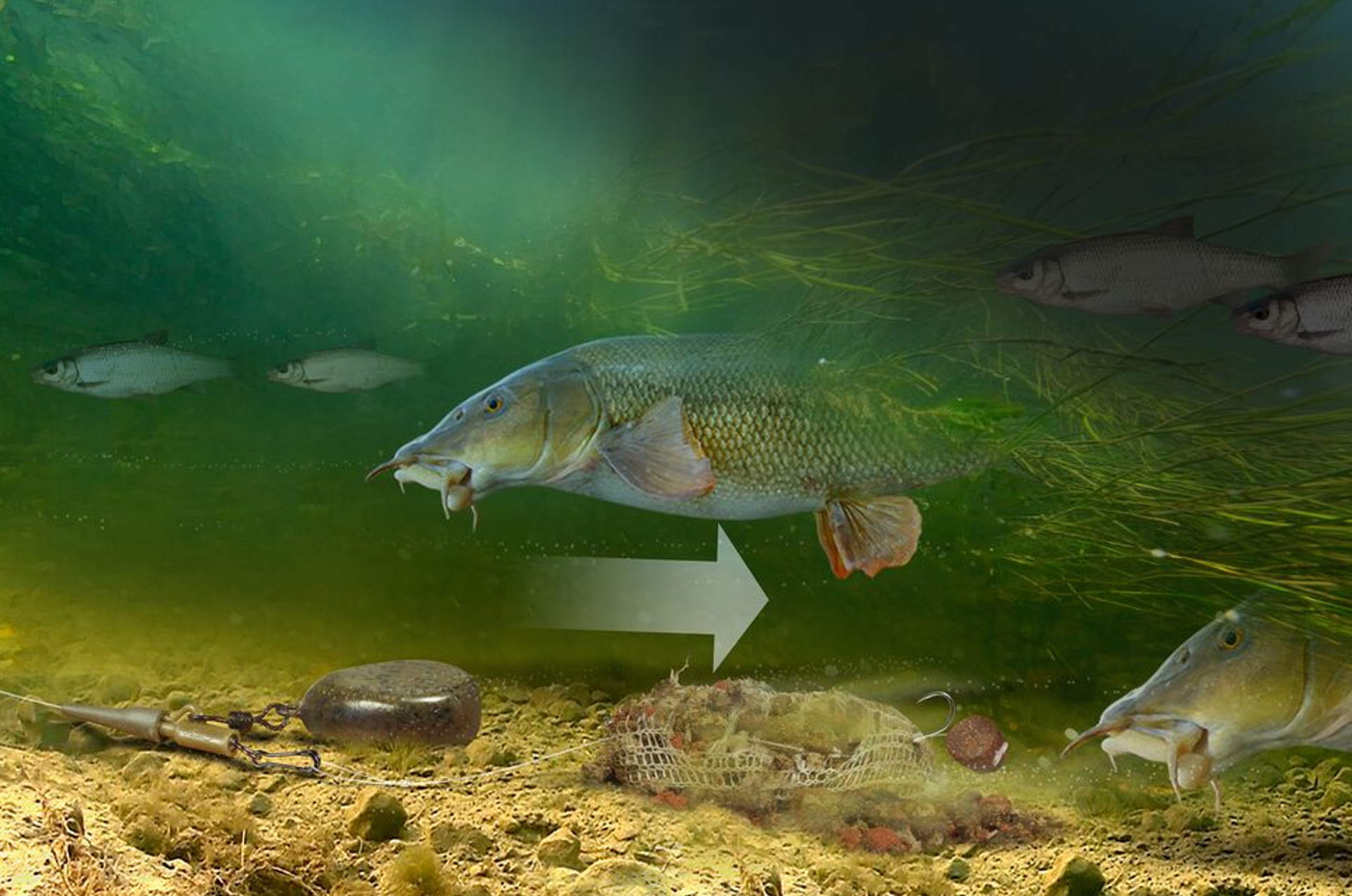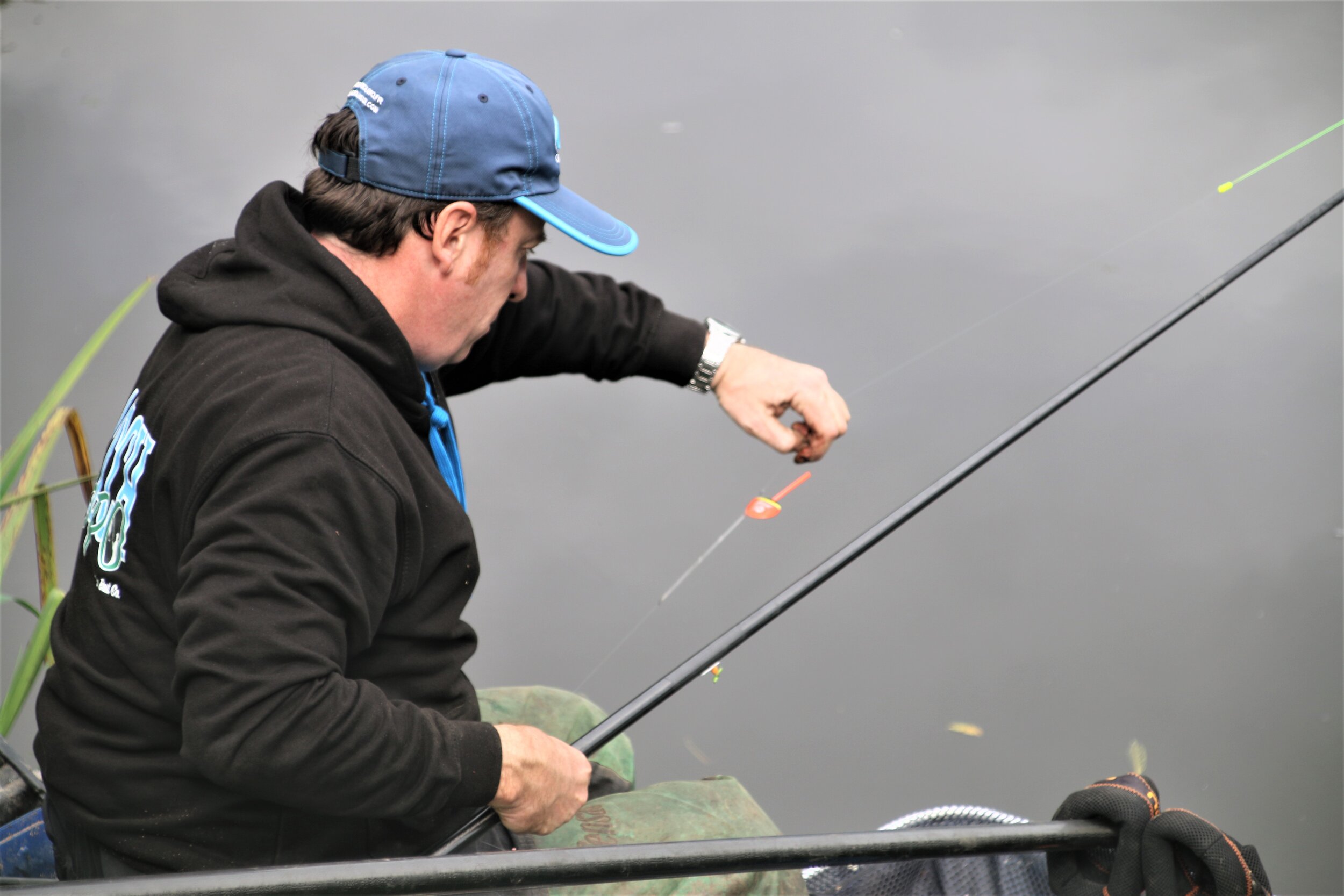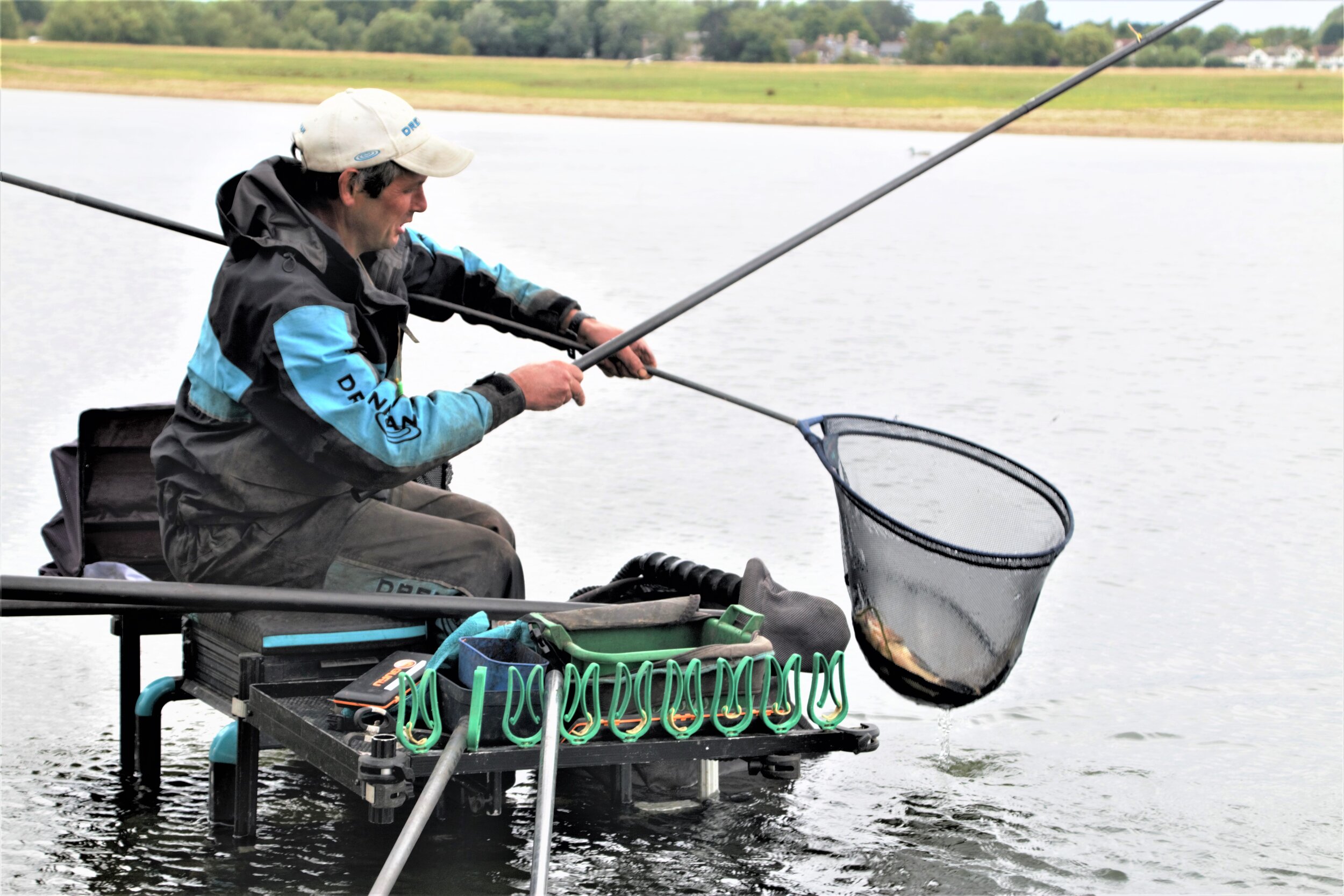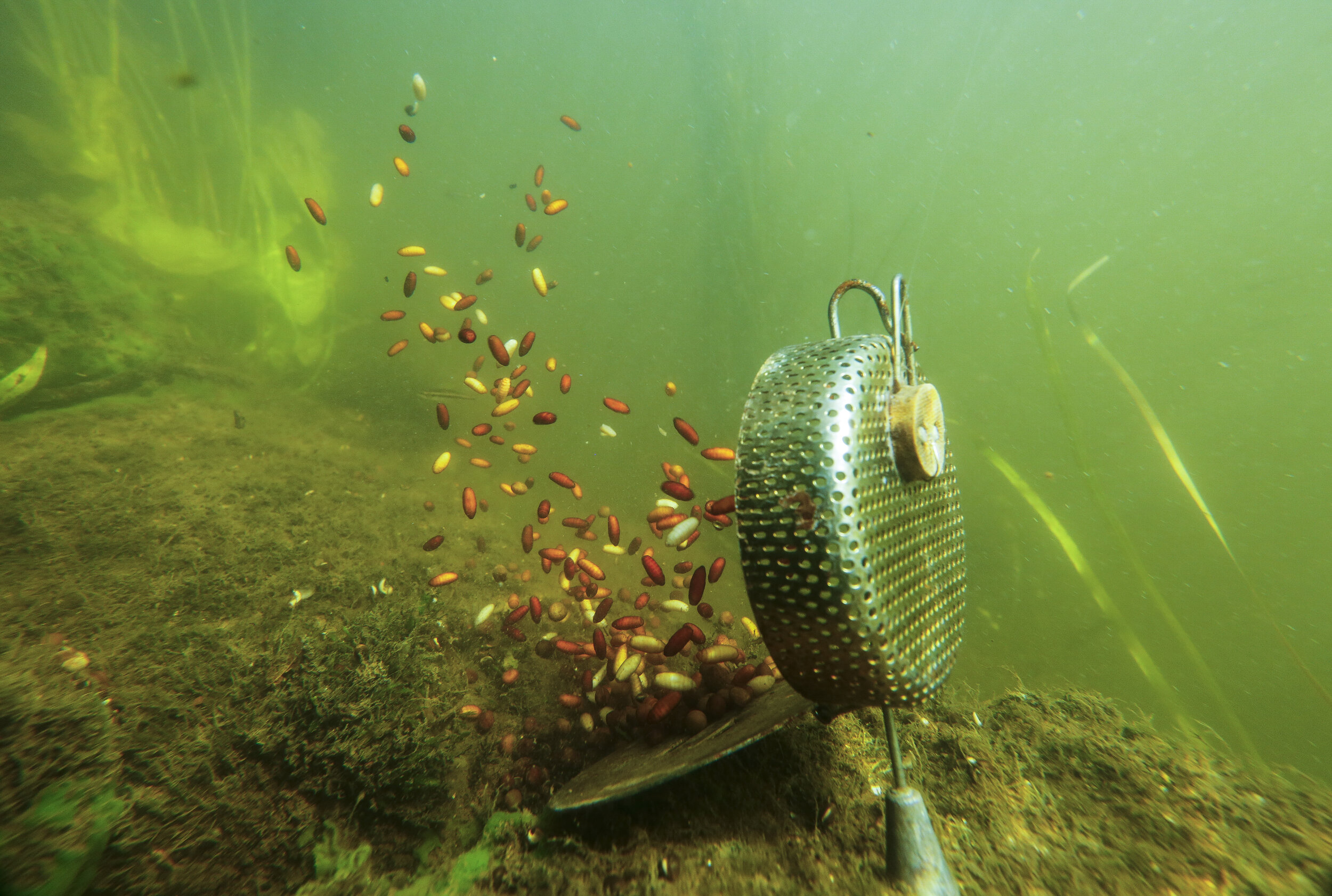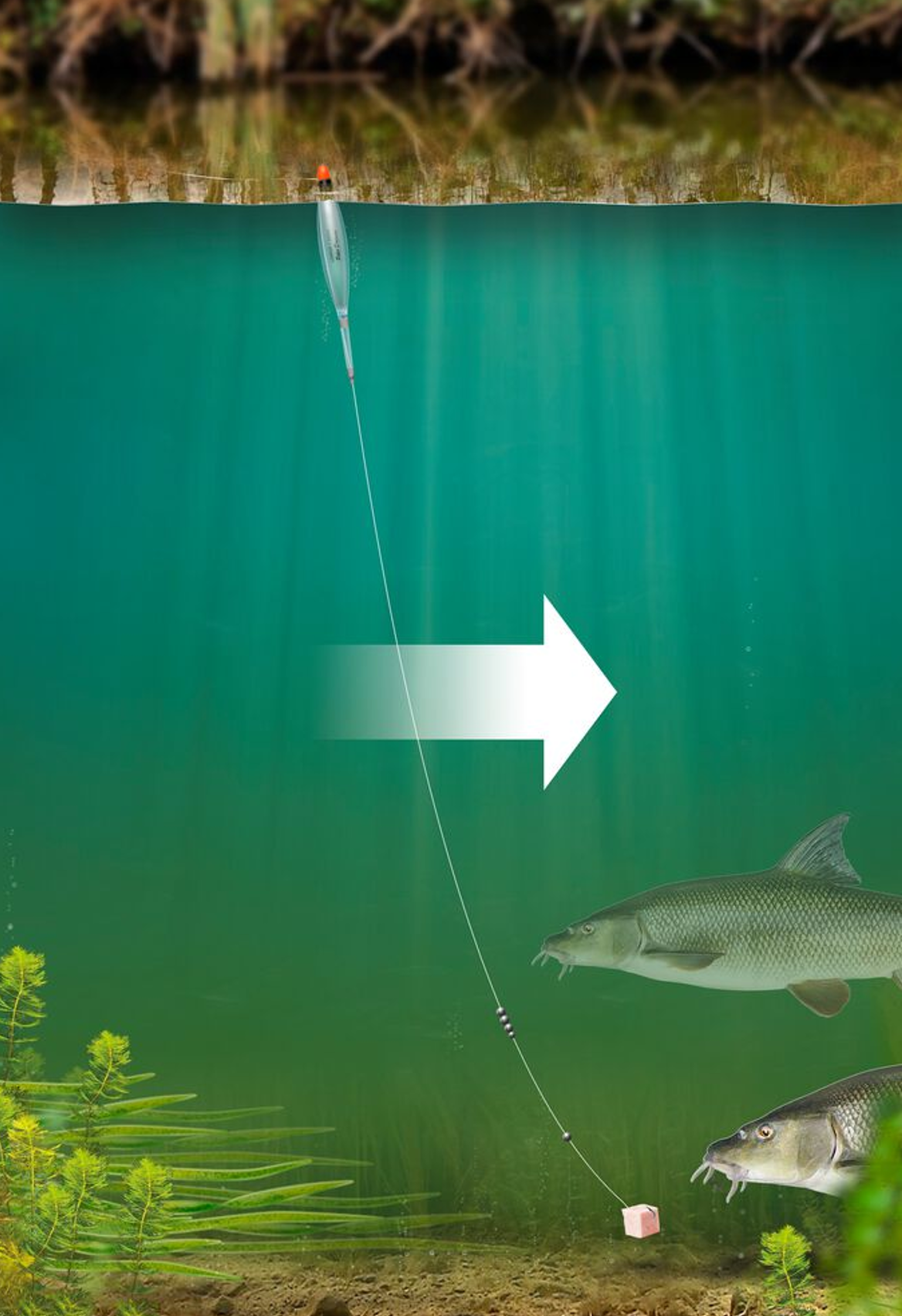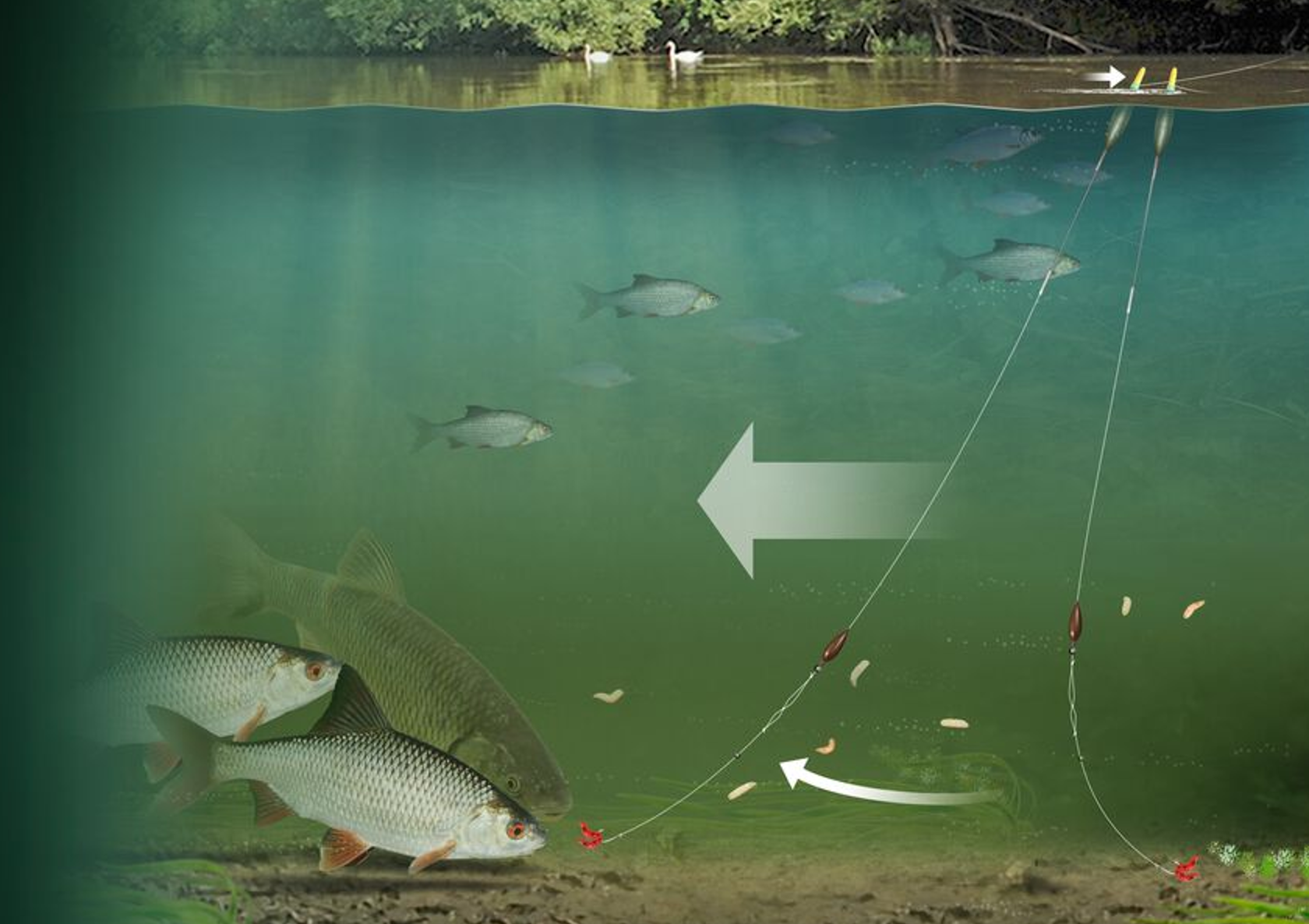River Fishing Tips | How to set up a flat float - Darren Cox
The flat float rig
IT MAY look tricky, but setting up a flat float is easy once you’ve done it a few times.
On a river the idea is to present the bait well overdepth and completely static. That means plumbing up so there’s anything between 12ins and 24ins of line and the bait laid on the riverbed.
To do this, set up with a single large dropper shot under the olivette and put a clip-on plummet on the shot.
Plumb as normal so that this shot effectively ends up just off bottom with that long bit of line on the bottom below it. You can add a few small shot to the line on the deck if you want to make sure the bait remains totally still.
I’d shot the float to leave around half the bristle on show. When held back, the bristle will rise up slightly but without having any of the float body come out of the water. A 3g flat float will manage most situations but in very strong flows this could be upped to 5g.
Components
FLOAT - 3g Cralusso
LINES - 0.16mm Garbo Line fished straight through
SHOTTING - Fix the olivette 12ins away from a large dropper shot set just off bottom
DEPTH - Set the rig to be fished 2ft overdepth
HOOK Size - 13 Kamasan B711
HOOKBAIT - A whole worm or three or four dead maggots
River Fishing Tips | How to find barbel on a flooded river - Dai Gribble
In prolonged floods, barbel seem to gradually move out of the main flow into slower flowing water. I suspect this coincides with them having fed well and preferring to rest up in areas where they need to expend less energy.
Barbel will move away from fast flows in prolonged floods
This helps you locate the barbel as once the river has been in flood for a couple of days, they are more likely to be found in the classic flood swims where the flow is less than in the main river.
I’d look for the following:
Bends with slack water on the inside and a crease where the main flow passes by.
Cattle drinks where there is slow-flowing or slack water out of the main current.
Slacker water behind overhanging obstructions such trees.
Deep holes where the barbel can lie in slower flows beneath the main pace of floodwater.
Slacks downstream of large bridge supports.
Search out slacker areas of water for barbel in times of flood
River Fishing Tips | The best way to attach a PVA bag when barbel fishing - Jamie Cartwright
The best way I’ve found is to thread the PVA bags directly on to the hooklink using a long baiting needle.
I use a quickchange swivel and tie a loop in the end of my hooklink, which allows me to quickly take off the hooklink, thread on a bag of pellets and boilies and slide it down so it rests against the hook, then reconnect the loop to the swivel.
I use a lead clip arrangement when using mesh bags. A running lead can slide back up the line and you get too much separation between the lead and the bag, making casting difficult.
This is a vast improvement on just nicking a bag on to the hook, as more often than not the first part of the PVA to melt is the bit attached to the hook, and the bag can just roll away!
Threading a PVA bag down the hooklink is a reliable way to present loosefeed when barbel fishing
River Fishing Tips | 5 tips for stick float fishing
A winner on running water in autumn, this versatile float always has the knack of catching better fish…
Hemp & caster
Maggots are fine for small fish, but when quality is on the cards, it’s hard to see past hemp and caster for feed. Chub, barbel and big roach love them, and they’re baits that sink relatively quickly.
Each bait does a different job, though, the hemp getting to the bottom quickly to keep the fish in the peg while casters fall slightly slower and will draw fish from downstream. A ratio of 75 per cent hemp to 25 per cent casters is about right, using maggot on the hook to begin with and then changing to caster as the fishing improves.
For quality fish, choose hemp and caster
Find a spot with smooth water
If you have a peg with some erratic flow that’s got water swirling and boiling all over the place it will be impossible to get the bait to run down the same place every time, and that will make it impossible to concentrate the fish in one area.
You need a spot with a steady glide to allow you to run the float through the same spot every time, enabling you to build up the area with loosefeed and get the fish hunting for bait. Take time to study the swim and work out where the smooth water is.
You need a steady glide to allow you to run the float through the same spot every time
Cast downstream
To ensure control of the rig at all times as it trots down the swim, make each cast slightly downstream. This means the line is behind the float and cannot overtake it, which would otherwise pull the rig off line. Keep mending the line, taking up any slack that forms so you are always in direct contact with the float to hit bites quickly and sharply. Feed in front of you, though, because this will mean your hookbait ends up among the loose offerings a little further down the peg rather than standing out on its own.
Always cast slightly downstream
Vary your presentation
Changing how the bait travels through the swim will catch more fish. Allowing the rig to run through the river will work, but holding the float back gives fish that aren’t going to chase a bait the chance to take it.
If you find a spot where you are getting a lot of bites, hold the float back there for a couple of seconds, as more often than not the float will bury!
Keep ringing the changes to keep the bites coming
Size matters
This is where a lot of anglers go wrong. Pick too light a float and you’ll not have control of the rig or be able to cast far enough. A good rule of thumb is to use a No4 shot for every foot of water, so in 5ft swims, go for a 5x4 float or in 9ft a 9x4.
As far as stick float patterns go, in smooth, steady water a classic straight stick made of balsa will be perfect. In uneven flows, a float with a slight shoulder and an alloy stem will give you stability for great bait presentation.
Don’t go too light on the float
River Fishing Tips | How to stop bumping off roach on the float - Hadrian Whittle
The most common cause of bumping fish on a running line is allowing a bow to form between the rod-tip and the float, so when you strike, you’re not direct enough to the float and the fish aren’t hooked properly.
Longer rods and silicone line spray on your reel can help solve this.
Another issue could be hook size. Try going up one size, a 16 for double maggot and an 18 for single, for example.
Soft, tip-actioned rods are vital for roach.
Learn the perfect roach stick float rig by clicking here.
River Fishing Tips | Get the most out of the flat float with Steve Maher
The flat float first gained popularity in the UK off the back of England’s World Champs win in Paris back in 2001, when massive disc-shaped floats taking up to 40g of weight were used to catch eels on the River Seine.
Slowly, anglers on home soil began to cotton on to the effectiveness of these unusual bits of kit that were brilliant for slowing a hookbait down to a virtual standstill, even on the most powerful rivers.
Now, almost 20 years on, if you watch a match on a river that’s carrying a little bit of extra water, you’ll see plenty of flatties set up and ready to go.
The flat float is brilliant for slowing the hook bait to a standstill on even the most powerful of rivers
But there’s more versatility to the flat float than it being just for flood conditions. On a medium-paced river like my local River Severn around Bewdley and Stourport, the float is ideal for catching perch, bream and skimmers. These species much prefer a bait that’s stood still or only just moving through the swim, the type of presentation you can’t get by using classic round-bodied pole floats.
Perch are a great target with a flattie
The flat float works by the thin circular-shaped body turning thin side on into the flow when lowered into the water. This means that there’s far less body surface area for the current to get hold of which, with a normal-bodied float, would pull the rest of the rig and the bait off bottom because the float wouldn’t sit straight. This doesn’t happen with a flat float.
Originally, this float was designed to nail a bait totally still on the bottom, but where perch are concerned, I’ve found that letting the bait run slightly can get more bites. The process here is to lower the rig in and then hold it still for 10 seconds, keeping the line from the pole to the float tight. Then lift the pole-tip and let the float travel through the swim, only for about four or five inches, and then hold it still again. Repeat this process until you reach the end of the swim.
Fishing well overdepth is the norm for flat float work and it’s possible to have up to 2ft of line laid on the riverbed at times.
Experimentation is key, and fishing with the bait just touching bottom can get better results on some days. I begin by fishing around the length of the float overdepth and make adjustments from there.
Experimenting with the depth is key to success on the flat float
Shotting a flat float is also easy and, if anything, I like to fish with the float overshotted (carrying too much weight).
For a 3g float, I’ll use perhaps 3.25g. I know that this means the float will sink, but because you’re holding the rig still a lot of the time and only letting it run down the peg a few inches at a time, that doesn’t matter.
Overshotting the float also makes bite indication brilliant!
Here are my six top tips for flat float fishing…
Delicate flat float
As well as a standard 4g Sensas Stach I also use a 2g Sensas Pawe – more delicate, with a thinner tip and the use of smaller dropper shot.
Change your hooks
If you catch a lot of perch, your hook can blunt. If I lose a run of fish, I change the hook! My favourite is the Tubertini Series 18 in a size 16.
Go past the feed
Sometimes the fish can be fussy and won’t sit right over the feed. When I get a lot of small indications but no proper bites, I’ll add a 0.5m extension.
Different baits
Worms are unbeatable for perch, but if I feel there’s a chance of skimmers or bream, I’ll always use dead fluoro pink maggots.
Groundbait
I will always feed groundbait at the start. I use eight balls of ABC Baits River and Roach, holding hemp and dead maggots to draw in prey fish
Give them maggots!
I will also feed maggots and chopped worm with a bait dropper. The worm needs to be finely chopped so it doesn’t fill the fish up.
River Fishing Tips | How to shot a stick float - Kelvin Tallett
The stick float is a fantastic method, offering superior presentation to the waggler for close-range fishing on rivers. But there is much more to it than simply setting the float at the depth of your swim and running it down with the flow.
Constant adjustments should be made to your rig and feeding to keep in touch with the shoals of fish.
A typical shotting pattern is using the shirt-button option where each shot is evenly spaced down the line, like the buttons on a shirt. This gives the hookbait a very natural fall of the bait through the water.
Stick floats are best shotted ‘shirt button’ style
When you hold the float back against the current, it will allow the bait to rise up slightly off the bottom, which can produce a bite when running the rig through normally won’t. A bulk of shot is very rarely used when fishing the stick float.
Get the stick float right and big bags of fish await you
River Fishing Tips | Six tips to make river fishing easy with Lee Kerry
Tackling flowing water is one of the most exciting challenges in fishing.
The way that fish behave in moving water is totally different to how they behave in still water. On a river, they will generally sit in line with the flow and compete for food, and there are a number of ways that you can go about trying to catch them from this line.
Choose your species
When a river is low and the water clear, target smaller fish like roach, dace and perch. If the river is carrying extra water and colour, skimmers, bream and barbel can all switch on.
Have feeder options
Use an open-end feeder with SonuBaits Black River groundbait if the river is coloured. Alternatively, to kick off a peg, use a blockend with hemp, maggots or casters.
Use sturdy tackle
I use an Extremity 520 reel paired with a 12ft 6ins Supera rod – a great balance for many fast-flowing rivers using feeders to 2oz. Mainline is 6lb Sinking Feeder Mono.
Balance the rig
Fish with a bow in the line and the rod pointing downstream towards it. Balance the weight of the feeder with the flow, so as a fish picks up the bait, the bite shows as a drop-back.
Cast regularly
Early in the session, I’ll cast every minute to get a steady stream of bait in the swim and attract the fish. Later, I’ll lengthen the gap between casts to around three minutes.
Don’t go too short
Long hooklengths are best as the bait will sit downstream of the feeder and be the first thing the fish finds as it moves up to the feed. A size 16 to 0.15mm mono is a good all-round choice.
River Fishing Tips | 5 Tips For Barbel
Go for the gravels
Although a swim on somewhere like the River Severn might seem to have a similar depth and pace all the way across, there are definite areas that barbel prefer. The most productive of these will be shallow water, which in turn will be much faster and better oxygenated in summer when rivers are often low and sluggish. Combine this with a gravel bottom and you’re in business.
Gravels are a hotspot for barbel
Use enough lead
As with any type of fishing, your rig needs to act naturally in order to get a barbel to take the bait. That means keeping everything nailed to the deck. A feeder that’s carrying too little weight to hold bottom will roll down the swim, with no chance of a fish picking up the bait. Before the session, cast with a range of different weights of feeder until you find the one that holds bottom just where you want it. Be aware that the flow could increase when you start fishing, so have some even heavier feeders to hand just in case.
You need enough lead on the feeder to hold bottom
Don’t go undergunned
Barbel fishing isn’t like going after roach or dace. You have to make sure that you are able to take control of every battle and that means using suitably robust tackle. A long hooklength is important because the fish seem to spook and feed less confidently close to a feeder. Start with a 5ft tail of around 0.20mm hooklength material, matched to strong size 12 or 14 hook.
Don’t go too light for barbel
Old school baits can be the best
Pellets are catching ever more barbel on rivers, but at times they can be a bit too much of a slow burner. For a more high-impact feed, it’s hard to see past hemp and casters. These small particles, introduced via a blockend feeder, will keep fish grubbing around for ages and pull other valuable fish, such as chub and perch, into the area too, letting you catch these while waiting for a barbel to pull the rod in!
Hemp and casters are deadly barbel baits in clear water
Put a bow in the line
If you keep a very tight line between the rod tip and feeder when barbel fishing, then you’re asking for trouble! Bites can be ferocious and before you’ve even picked the rod up you could have been broken, even when using heavy gear, due to the lack of forgiveness in the set-up.
The solution is to have a bow in the line, which means that the line is slacker and creates a cushion that reduces the chance of being smashed. Bites when fishing like this will normally be a sharp knock on the tip and then a drop back as a fish moves the feeder and the line slackens off.
Fish with a bow in your line
River Fishing Tips | Running or fixed feeder for chub? - Hadrian Whittle
My rig actually works on both principles – it’s a hybrid of a running and fixed set-up. The feeder slides on the line and is stopped above a short length of twisted line via a float stop or bead.
The black-cap feeder rig
Above the feeder is another stop that can be slid up and down to increase or decrease the gap between the stops and, thus, how far the feeder can move.
By leaving just an inch gap and having the feeder balanced to just hold bottom, anything taking the bait moves the feeder, which then hits the stop and helps to hook the fish.
There are days when lengthening this gap works, others when shortening it right up catches more.
A cracking river chub
River Fishing Tips | Six tips to catch big fish on the pole - Steve Harwood
RIVERS are full of all kinds of obstacles that make many anglers nervous when fishing for larger species such as bream, tench, chub and perch. Weed is the most common of these snags but there's no need to put the pole away when fishing around the green stuff. Here are six of my top tips to beat it…
Big river fish can be caught on the pole
Use heavy floats
Get the bait down fast with a float from 1.5g to 2g and all the weight down the line.
Big floats help get the baits down fast
Big baits rule
Two halves of dendra worm are best for Thames bream and perch, fished overdepth.
Try fishing big baits over depth
Get the feed down
Roughly chopped worms are packed into crumb with casters and dead maggots.
Pack your ground bait full of feed
Don’t go too light
I use a 14-16 Gamakatsu 2210B hook with 0.15mm hooklength and 0.18mm mainline.
Don’t go too small with hooks
Soft & strong elastic
You’ll lose fish in the weed if your elastic is too light. I fish white or grey grade Hydrolastic: soft yet powerful.
Light elastic will see you lose more fish
Prime the swim
A baitdropper delivers choppy without spillage, allowing me to put the rig directly on top of where those worms are.
Bait droppers are great for delivering bait into a river swim
River Fishing Tips | What does it mean when fish cough up bait? - Darren Cox
Greedy species like perch and chub tend to regurgitate bait the most, but I’ve had roach and dace do it too.
When it happens, it tells me two things…
Firstly, that the fish are ravenous and eating well and secondly, that there may not be that many fish in the peg as the ones I catch are eating everything I’ve fed.
In this situation I then feed less bait, meaning there’s more chance of my hookbait being taken by the few fish that are present.
Fish coughing up bait can be a sign you need to limit the feed
River Fishing Tips | 5 tips to catch more roach on hemp
The prime time to catch big river roach on hemp is now! Here are five tips to help you get the most from the seed…
Regulate your feeding
No two days are ever the same when it comes to feeding hemp. A little and often loosefeed approach works on some rivers, while others respond to feeding larger amounts with a pole cup and then fishing over it. The standard approach, though, is to loosefeed with a catapult, around 20 or 30 grains of hemp each time and, using a slow-falling rig, catch fish as the bait settles. If the roach show signs of coming up in the water to get to the loosefeed, break out the pole cup and get them back on the bottom with
a good helping of hemp fed in one go.
Every day is different when it comes to feeding with hemp. Watch how the fish behave.
Stop nuisance ‘shot bites’
A normal pole rig for fishing hemp consists of a light float and small shot strung evenly down the line to give the hookbait a slow fall. Sometimes, though, fish grab those shot, mistaking them for grains of hemp. So switch to cylindrical styl weights instead. The slow fall of the bait is still guaranteed but there’s no longer a danger of the fish grabbing them.
Look out for fish taking the shot instead
Hook it right
MANY anglers have difficulty in getting hemp to stay on the hook. But it’s easy when you know how. There are two ways to hook hemp, but first ensure the grain has a full split in its side but isn’t falling apart. The quickest way is to push the bend of the hook into the split so the sides of the grain grip the hook point and shank. You’ll get a more secure hookhold by punching a hole in the flat end of the grain with a baiting needle and threading the hook point, bend and shank through until the seed hangs off the bend. You can catch several fish on the same grain before it will need replacing.
There’s no need to struggle hooking hemp
Switch hookbaits
Hemp isn’t the only option you have to put on the hook. When the roach are present in numbers, bigger fish can be picked off using tares, and on some rivers even elderberries will catch their share! Tares are a hard particle used as pigeon feed, but when cooked they turn soft, are easy to hook, and have the knack of catching the bigger roach in a shoal. Don’t spend too long fishing them without bites, though, as you’ll either catch quickly on them or not at all. Elderberries are an old-fashioned bait rarely used today, but especially on rivers where elderberry bushes line the banks, the berries are eaten by roach and slipping one on the hook might just mean lift-off for the peg!
There are some great alternative baits to fish alongside hemp feed
Use small floats for a slow fall
To create that slow fall of the bait with the small strung-out shotting pattern, the pole float you use needs to be on the light side. You’re not after stability from the rig when fishing hemp, so even in 10ft of water, a 0.5g slim-bodied float will be ample and, in shallower swims, you can go even lighter.
You want the bait to fall slowly through the water with hemp, so use as light a float as you can get away with
River Fishing Tips | Perch on the pole with Cameron Hughes
Faced with the whole river to go at, I look for a couple of things where perch are concerned – a slow flow and good depth close to cover.
River perch like slow flow and cover
Cover is vital as it gives perch an ambush point, so reeds, weed or lilies are good but there has to be sufficient depth, certainly a minimum of 5ft.
In some swims, you won’t have that so you’ll have to work with what you’ve got. Slacker water is important because again, perch will wait here to ambush smaller fish – I’ve never found them to be that keen on sitting in the main flow.
In many instances, you’ll be almost margin fishing with the pole pointing down the edge of the river. The pole is unbeatable for precision placement of the hookbait close to cover, and would always be my choice over rod-and-line tackle.
The margins are a real hotspot for river perch
River Fishing Tips | How to catch more barbel in the day - Phil Smith
There are a few things you can do to boost your daytime catch rate, starting with targeting waters that don’t allow night fishing.
A fantastic conditioned double caught in daylight hours
It may seem strange, but on venues where night fishing is allowed, it appears to encourage the fish to feed better in darkness, and less during the day.
I’d also recommend smaller baits, the obvious ones being maggots or casters. Bait droppering with hemp and caster, say, 10 droppers of each, then leaving it without casting in for an hour will get results.
Casters are a deadly bait in the daytime
For hookbaits, I favour hair-rigged casters or maggots mounted directly on to a size 12 hook. Some of my best specimens have fallen to these tactics.
Fake casters are a good hook bait to avoid small fish
River Fishing Tips | The best float rig for barbel - Dai Gribble
SOME people favour using big wagglers, especially if it’s windy, but most of the time when trotting for barbel I use two types of float – Chubbers and Avons.
I use both Chubbers and Avons
Avon floats, with their large shoulders and heavy wire stems, are best suited to deeper water and slower flows, while the more streamlined Chubbers, or Loafers as they’re sometimes called, work best when used in shallower, faster water.
It’s important to use a big enough float to boss the river, rather than letting it boss you, so I rarely use a float with less than 3AAA loading and, depending on flow and depth, I will use them as big as 5SSG.
I start with the bulk of the shot set 50cm-60cm from the hook, with a single dropper shot, generally a BB, between the bulk shot and the hook.
A standard barbel float rig
Although barbel will sometimes take a bait presented off the bottom, I want my bait running along the bed of the river as that is where it is most likely to be taken, so my shotting is designed to get the bait down to the feed area as quickly as possible.
They are great fun on the float!
River Fishing Tips - How to fish for Wye barbel - Kevin Clark
The River Wye is one of the most scenic, prolific and best barbel rivers in the UK.
If it is your first time on this beautiful river, however, it can be a bit daunting due to its large and powerful nature. So how should you approach the fishing?
At the start of the river season you should be fine with a quality 8lb mono, a 1.5lb test curve rod and a reel with a good clutch.
I’d suggest a 2oz gripper lead and an open-end feeder to start with. Try casting upstream, which helps to hold bottom with less weight – handy if you’ve forgotten your feeder add-on weights or you’re slightly undergunned with your leads. Let a bow of line out between rod-tip and feeder before sitting the rod on the rest.
A gripper lead will help you hold bottom
A high oil pellet approach should serve you well on most Wye stretches, or small cubes of meat on 8lb fluorocarbon hooklengths, provided your stretch is not too snag-ridden.
Kevin Clark with the Wye record barbel of 14lb 12oz
River Fishing Tips | The best method for early season chub - James Champkin
This may sound crazy, but my number one method for early season chub is to use lures!
I was introduced to it a few years ago, and it’s the most exhilarating style of chub fishing I’ve ever done.
I use small (5cm-7cm) floating crankbaits and work them slowly down the flow, with the rod tip held high, so that the lure wiggles enticingly on the surface.
Lures with a fat body and a large rattle work well, but I’ve also been experimenting with insect imitations, which have proved deadly.
Cast long upstream and try to work your lure close to any overhanging trees. Stay alert - takes can be explosive!
Chub love to hit lures!
River Fishing Tips | How to avoid small fish to catch barbel on the float - Hadrian Whittle
If small fish are a nuisance on the float when barbel fishing, I have two bigger bait options. My first choice is an 8mm piece of meat hooked on a size 12 Gamakatsu 2210 Blue or a Kamasan Animal hook. If this fails, then I’ll try an 8mm or 10mm pellet.
Barbel can be great fun on the float in the summer months
I like to carry some halibut, Red Krill and natural carp pellets to give me a colour variation to try throughout the day. These are put in a band on a short hair rig. As for feed, lots of hemp and caster is key. I will feed a few 4mm and 6mm halibut pellets and a few cubes of meat in this as well.
Feed a mix of 4mm and 6mm pellets with the some cubed meat thrown in.
If small fish are a real nuisance, then try not adding any casters to your feed.
A beautiful float caught Wye barbel
River Fishing Tips | Avon or Stick float for big roach and chub? - Paul Garner
Trotting is such an effective way to catch larger river fish and I don’t know why more people don’t do it!
Trotting is a great method for larger river fish like chub
To me, it’s a job for the Avon float. Its body is buoyant enough to carry the weight needed to keep a bait down close to the bottom and the thick tip rides the current and is not dragged under when the hooklength touches the river bed.
As a rule of thumb, use 1g of weight for every 2ft of depth. This may see you using large floats in deep swims, but it is essential to keep the bait down.
The pronounced shoulder means that the float can be held back, slowing its progress to around half that of the flow at the surface. This pace more closely matches the current close to the riverbed, producing a more natural speed as the bait is swept downstream.
A typical Avon float rig




